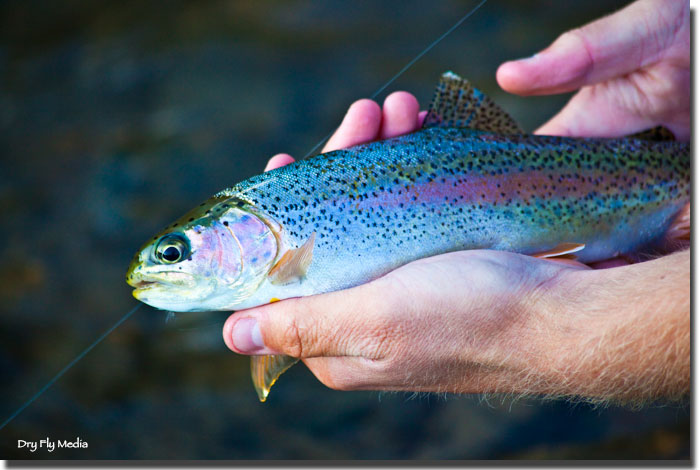
[After asking about it a few weeks ago, we’re still getting emails (and a couple of calls) offering wit, wisdom, opinion and insults in the ‘discussion’ regarding replacing now wild, sustaining fish populations with (perhaps or not genetically pure) native species. The can of worms we opened here was particularly focused on trout in the Greater Yellowstone region (clearly steelheaders have similar and damned strong feelings when it comes to the wild vs. hatchery fish debate – another time, another place).
Friend of Chi Wulff Quinn Grover fired this very nice article on stocked fish over to see if we thought it fit the topic – it does. It’s a bit long for blog reading in a single bite, so here’s part one. – Mark]
Some fishermen call them pelletheads. Others call them boots or planters or stockers or some other name that indicates they are a slightly less-than-desirable version of the genuine article. If fishing is a sport, a lot of fishermen consider hatchery trout to be the minor leagues.
Perhaps Gary Lafontaine summed it up best when he described the way fish react to us fisher folk: “A trout always knows you’re there. Every time…You can’t hide…Hell, even a hatchery fish knows you’re there. The difference is that he’s glad to see you.”
Growing up, I never thought much about the difference between hatchery-raised trout and those born and reared in the wild. A fish was a fish, I always figured, unless it was a whitefish, which was only a fish if I was getting skunked. As I grew in the culture of fly fishing I began to learn about hatchery trucks and spawning and redds and food pellets and the color of a wild brown trout in the late fall. And I learned (shockingly) that whitefish are native. That spun my perception on its axis for awhile, and the more I learn about native trout and hatchery trout and “wild” trout (fish that are not native, but that were born and matured in a wild stream), the more difficult it is to set things right.
I don’t know a whole lot about hatcheries, really, which is my own fault. My cousin is a biologist and worked in trout hatcheries for years, so it’s not like I didn’t have the chance to learn. Unfortunately, the whole process seemed to wear him out. At family reunions I try to engage him in conversation about our speckled swimming friends, and he usually replies that he would rather not lay eyes on another trout as long as he can see, which is a shame. Who wouldn’t want to look at trout?
Someone who stares at swimming pools full of pellet-fed rainbows day in and day out, I suppose.
I know a lot of fishermen are tired of hatchery fish as well. Oregon-based trout philosopher Ted Leeson surmised: “In local angling circles, these trout arouse a species of contempt otherwise reserved exclusively for the Los Angeles Lakers.”
It’s hard not to fantasize about all the hatchery money being redirected into making life better for the wild version of the fish, the Real McCoy, as we like to think of them. But wild browns and rainbows are still less authentic than native cutts and bull trout, if you want to get technical (at least in the “that’s the way God planned it” version of authenticity). Still, for some reason the rush to catch natives over wild fish is less pronounced than the way we look down our noses at pelletheads.
There are few (relatively speaking) hardcore chasers of native trout—fishermen who want only to catch those fish who can trace their evolutionary ancestry to a prehistoric streambed, before man learned fire and used it fashion hatchery pens and fishing rods.
Sure, nearly every fly fisherman wants to catch one or two natives before rowing their drift boat to heaven, but if you were to give most anglers the choice between a bright native 12-inch westslope cutthroat and a wild 19-inch brown trout whose great-great-great-grandparents were ejected into the stream via hose, plenty of so-called purists—young and old—will opt for size over lineage.
So what is the difference? Why are wild fish so superior to hatchery slugs, yet natives are only better under certain conditions?
I don’t know. I am really only sure that none of the previous statements will stand up to absolute scrutiny and that the answers are different for each angler. If you dig deep enough into the specifics rather than the generalities of the subject, you will find contradictions aplenty, and standards routinely bent (or flat out broken) if the fish are big enough to merit an exception.
Planters truly do provide an alternative to emptiness in many cases. There are waters with no angling history beyond that of a hatchery truck, a hose, a lot of Styrofoam worm cups, and a host of red and white bobbers. I don’t begrudge that. Plenty of kids get hooked on fishing that way, and plenty of adults, too. But after those clear cases, things get hazy.
Part two to come.

